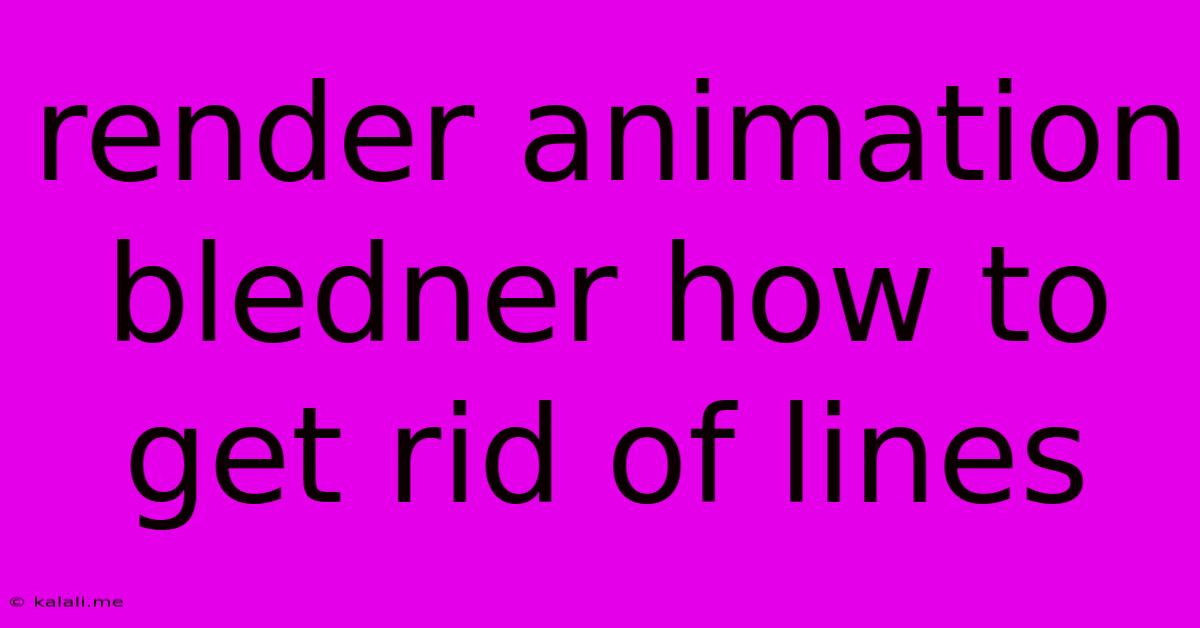Render Animation Bledner How To Get Rid Of Lines
Kalali
Jun 01, 2025 · 3 min read

Table of Contents
Banishing the Lines: A Guide to Smooth Animations in Blender
Rendering animations in Blender can be a rewarding experience, but sometimes you're left with unsightly lines and artifacts marring your otherwise beautiful work. This frustrating issue can stem from a variety of sources, but with a systematic approach, you can achieve clean, smooth animations free from distracting lines. This guide will walk you through the common causes and effective solutions for eliminating these rendering blemishes.
Meta Description: Learn how to eliminate distracting lines and artifacts in your Blender animations. This comprehensive guide covers common causes and effective solutions for achieving smooth, professional-quality renders.
Understanding the Source of the Lines
Before diving into solutions, it's crucial to understand why these lines appear. Several factors can contribute to this problem:
-
Insufficient Samples: The most common culprit is a low sample count in your render settings. Samples determine how many light rays Blender traces per pixel, directly impacting the quality and smoothness of your render. Lower samples lead to noisy renders, often manifesting as lines or jagged edges.
-
Insufficient Render Resolution: A low render resolution can also result in aliasing, which appears as jagged lines and stair-stepping, especially on curved surfaces or sharp edges.
-
Mesh Problems: Issues with your 3D models, such as overlapping faces, non-manifold geometry (geometry that violates Blender's rules for valid meshes), or poorly-defined normals, can cause rendering artifacts including lines. Inspect your meshes carefully in Blender's Edit Mode.
-
Material Issues: Certain material settings, especially those with sharp transitions or highly specular reflections, can accentuate lines or create their own artifacts.
-
Object Interactions: Problems with how objects interact during animation, such as improper collision detection or overlapping geometry over time, can result in lines appearing during specific frames.
-
Compositing Issues: If you're using the compositor, problems with nodes or settings there could introduce lines.
Troubleshooting and Solutions
Now that we've identified the potential culprits, let's explore practical solutions:
1. Increase Render Samples: This is often the most effective solution. In your render settings (usually accessed via the Render Properties panel), locate the "Samples" section. Experimentally increase the number of samples, especially for those areas showing more lines. Start by doubling the amount and render a test frame; you'll likely see a significant improvement with even a moderate increase. Keep in mind that higher sample counts significantly increase render times.
2. Increase Render Resolution: Similar to samples, increasing your render resolution will lead to smoother renders. However, this also greatly increases render time. Find a balance between quality and efficiency.
3. Clean Up Your Mesh: This is crucial. In Edit Mode, carefully inspect your meshes for any problems:
- Remove Doubles: Use the "Merge by Distance" tool to remove any duplicate vertices.
- Check for Non-Manifold Geometry: Blender will often highlight these areas. Fix them by adjusting geometry.
- Recalculate Normals: If normals are incorrect, recalculate them using the "Recalculate Normals" option.
4. Review Material Settings: Examine your materials. Avoid overly sharp transitions between materials. Use smooth shading and consider adjusting roughness and specular settings to minimize hard edges.
5. Address Animation Issues: Carefully review your animation process, paying attention to any potential object collisions or overlaps. Implement collision detection if needed.
6. Check Compositor Settings: If using the compositor, thoroughly examine all nodes and settings for potential issues that might be introducing lines.
7. Use Denoising: Blender offers integrated denoising in the render settings. This can effectively reduce noise and lines without increasing render times significantly, but it won't magically fix problems caused by poor mesh topology or other fundamental errors.
Preventative Measures
The best way to deal with rendering lines is to prevent them in the first place. Develop good modeling habits, always clean up your meshes before rendering, and understand the effect of your render settings. Start with a high enough resolution and sample count to avoid issues from the outset.
By following these steps, you can significantly reduce or eliminate lines in your Blender animations, resulting in cleaner, more professional-looking renders. Remember that patience and experimentation are key – finding the optimal settings for your specific scenes will require some trial and error.
Latest Posts
Latest Posts
-
How Many Sorcery Points Per Level
Jun 03, 2025
-
Best Probability Book For Self Study
Jun 03, 2025
-
How To Know If A Proline Is Cis Or Trans
Jun 03, 2025
-
Why Is Macbook Monitor Display Disconnecting And Reconnecting Every Minute
Jun 03, 2025
-
How To Send An Imessage Instead Of Text
Jun 03, 2025
Related Post
Thank you for visiting our website which covers about Render Animation Bledner How To Get Rid Of Lines . We hope the information provided has been useful to you. Feel free to contact us if you have any questions or need further assistance. See you next time and don't miss to bookmark.